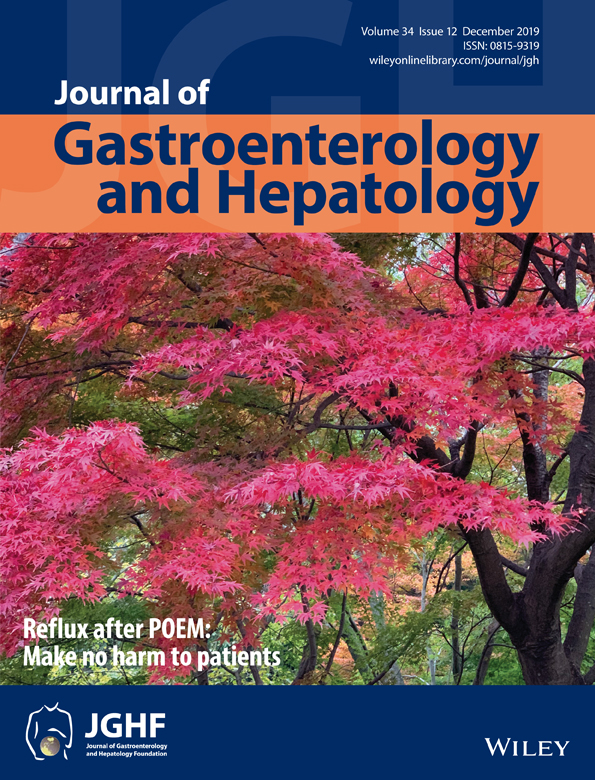Reflux after per-oral endoscopic myotomy: Do we have a solution?
Inoue et al.1 first performed per-oral endoscopic myotomy (POEM) for treatment of Achalasia in 2008, and over the past decade, numerous researches demonstrated that POEM is effective as a treatment for Achalasia. Recently, an international multicenter randomized trial demonstrated that POEM achieved significantly higher rate of sympomatic relief of dysphagia compared to pneumatic balloon dilatation for treatment of Achalasia.2 Systematic reviews and meta-analyses demonstrated that POEM achieved over 90% of symptomatic relief for Achalasia without major morbidities.3, 4 However, there was a significant rate of gastroesophageal reflux (GERD) after POEM. Repici et al.5 conducted a systematic review comparing risk of GERD after POEM against laparoscopic Heller's myotomy and fundoplication (LHM). The pooled rate of abnormal acid exposure upon pH studies was 39.0% after POEM and 16.8% after LHM, and the rate of esophagitis was 29.4% after POEM and 7.6% after LHM. However, clinical studies showed that patients after POEM had a lower rate symptomatic GERD despite the obvious high rate of abnormal acid exposure and endoscopic evidence of esophagitis.6, 7 Researchers are still in search of the best definition of GERD after POEM.
The commonest approaches to perform POEM include anterior approach at 1 to 2 o'clock position or posterior approach at 5 o'clock position.7 A randomized trial comparing anterior against posterior myotomy demonstrated similar clinical efficacy in relief of dysphagia.8 While the incidence of esophagitis was similar between two groups, pH studies at 3 months post-surgery showed a significantly higher abnormal acid exposure for the posterior approach. One of the proposed etiologies for higher risk of GERD after posterior POEM is the incision to both clasp and sling fibers of the lower esophageal sphincter (LES). The LES is composed of a semicircular clasp fibers located over the lesser curvature side, and the sling fibers located more to the greater curvature which hooked around the gastric fundus forming the cardiac notch and embraced the anterior and posterior wall of the stomach.9 While both muscle groups formed the LES, the integrity of these in normal position would be essential for the antireflux mechanisms.
Patients who received laparoscopic Heller's myotomy without fundoplication had more than 50% rate of GERD10 as the classical Heller's myotomy include a full thickness cut 5 cm above and 2 cm below the gastroesophageal junction. According to anatomical arrangements, POEM through posterior approach will have a significantly higher chance of myotomy to both clasp and sling fibers which may lead to higher risks of GERD. Tanaka et al.11 first reported the two penetrating vessels (TPV) as the indicator of boundary between circular and oblique muscles in gastric cardia. In this current issue of the Journal, Tanaka et al.12 compared a recent cohort of patients with exposure of TPV during POEM against a conventional group without exposure of TPV. The results demonstrated that identification of TPV and preservation of sling fibers significantly reduced endoscopic evidence of grade B or higher esophagitis (31.3% vs 58.1%; P = 0.017) and a trend towards reduction in symptomatic GERD in TPV group (10.8% vs 19.4%; P = 0.23).
Per-oral endoscopic myotomy not only provides an excellent no-scar approach to perform myotomy; comparing to surgery, POEM allows a more precise dissection of the non-relaxing part of LES while preserving natural antireflux mechanisms around the gastroesophageal junction. This novel endoscopic myotomy required better recognition of anatomy around the GEJ to enhance its precision. The current study illustrated that identification of TPV enhanced anatomical localization of oblique sling muscle, allowing its preservation during POEM and avoid GERD. One important result of this study was the significantly higher integrated relaxation pressure (IRP) in the TPV group after POEM compared to conventional group. This high normal IRP is likely due to preservation of sling muscle while the new approach in POEM does not result in worsening of symptomatic relief. The result reflecting the preservation of sling muscle will not result in inadequate myotomy and an optimum myotomy to inner circular muscles with preservation of sling fibers can prevent GERD. Longer follow-up in randomized trial will be necessary to confirm these findings especially on the recurrence of Achalasia when oblique sling fibers were preserved.
In theory, anterior approach of POEM at 1–2 o'clock should avoid the oblique sling fibers and reduce risk of GERD.13 However, systematic review comparing anterior against posterior POEM did not demonstrate superiority for anterior POEM in minimizing GERD.14 The included studies had heterogenicity in the techniques of performing POEM, as some preferred full thickness myotomy around GE junction, while others varied in the extension of myotomy at gastric cardia. Posterior myotomy is the current favorable approach as the working channel is more aligned to the direction of posterior cutting which translates into a quicker operation and easier closure of mucosal entrance.7 Hence, identification of TPV will be one of the important landmarks to standardize the procedure for posterior POEM to prevent GERD. For patients with severe GERD after POEM, endoscopic antireflux therapy is becoming a possible solution. Inoue et al.15 reported the technical success in performing endoscopic fundoplication after POEM (POEM-F) for 21 patients, while Tyberg et al.16 reported the performance of endoscopic transoral fundoplication in five patients who had significant GERD after POEM and achieved 100% off PPI rate.
Tanaka's study in this issue of JGH provides an important key to prevent GERD after POEM through accurate identification of anatomical landmark of TPV in avoiding myotomy at the sling muscles during posterior POEM. It is worth some considerations.




